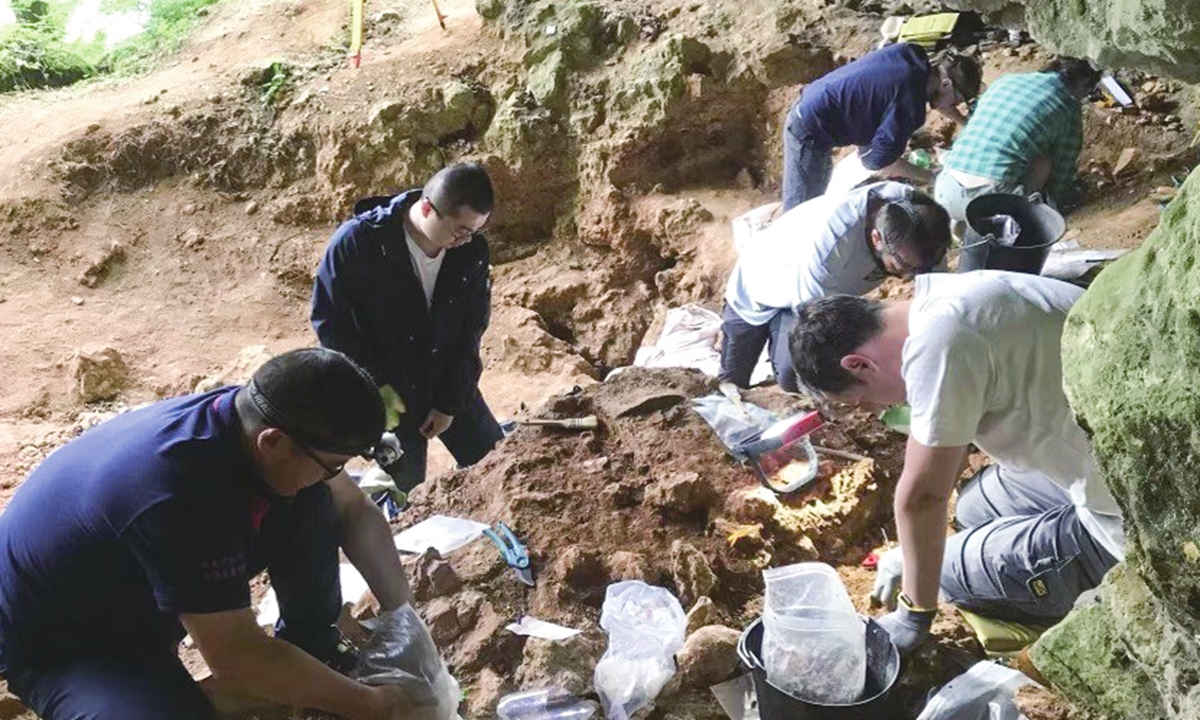
Project team members at the excavation site Photo: Courtesy of China-France Paleolithic project team
It might call up a scene from Stanley Kubrick's film 2001:
A Space Odyssey - a bone used by an ape as a tool flies through the air and transforms into a satellite floating through space.
In the director's fictional world, advanced human society has its roots in a small primitive discovery. The director's insight remains incredibly true in everyday life today, especially with modern archaeology constantly reminding us of the depth of human history.
In Dordogne Province, France, a human distal phalanx fossil a mere two centimeters in size, recently been found through the joint efforts of both Chinese and French researchers, is one of these "small" discoveries. Luc Doyon, a key figure in the China-France discovery, told the Global Times that this cross-cultural research carried out by these teams is also of significant importance to our understanding of humanity.
China-France partnership The human phalanx fossil was unearthed from a rock shelter that dates back 80,000 to 14,000 years ago in what is today the southern French town of Tourtoirac.
Once the site belonged to the Neanderthals, an extinct species that lived in Eurasia, but it was later taken over and used as a hunting camp by Homo sapiens, or modern human beings.
Doyon told the Global Times that having found traces of two species of humans at one site, the team was intrigued as they compared the two species' living patterns - a step forward for the inquiry of how we became the humans we are today.
Including the newly discovered fossil, the site has revealed other gems such as a pierced fox canine tooth, which Doyon revealed to the Global Times was likely part of a necklace made by ancient people 27,000 years ago.
The animal tooth was unearthed along with another milk tooth fossil - a profound reminder that human being's wisdom and longing for beauty extends back to prehistoric times.
From 2016, when excavations started, to their end in mid-June, a total of 40,000 objects were found.
Doyon said that aside from Neanderthal and modern human finger bones, stone tools and artworks are two other major types of discoveries made at the shelter.
The China-France research group was mainly composed of experts from Shandong University (SDU) and the University of Bordeaux in France. Doyon himself is a professor at the Institute of Cultural Heritage at SDU.
Being able to work together in the field was hard-earned.
The global setback of the COVID-19 pandemic postponed the excavation, so it wasn't until this year that Chinese experts were finally able to join the on-site excavation in France. Doyon also noted that French administration's approval of the project was essential and allowed the cross-cultural efforts to achieve fruition.
'Borderless subject' Discoveries from the rock shelter site marks the first Paleolithic collaboration in the 59 years of diplomatic relations between China and France.
Although Doyon was the project's team leader in France, Li Zhanyang, Doyon's peer archaeologist at SDU and his former mentor, was a deciding figure that helped initiate this China-France project back in 2016.
Three years after Li's initiative, the French Ministry of Culture approved it, leading to it becoming China's first collaborative excavation project in Europe.
Both sides have greatly benefited from it.
Chinese archaeologists had gained international experience and learned more about Western archaeological research by working with their French peers, while France has been able to uncover invaluable local relics and better protect them.
Before the excavation, the rock shelter site had long suffered from illegal excavations, which led to the loss of untold relics. The challenge of recovering lost cultural artifacts is a "common point of pain" for countries like France and China. Xiang Xin, an archaeologist, told the Global Times that only "systematic scientific intervention" can effectively reduce losses at these types of sites.
"We often call paleontology and archaeology 'borderless subjects.' We look at a site beyond investigating its value for regional history and see it as an inquiry into how it contributes to global understanding of humanity," Xiang remarked.
Doyon, who also told the Global Times about the "increasing importance" of cross-cultural projects, did not see the China-France collaboration as a novelty, but a tradition that has been carried out for a long time.
In 2015, Chinese archaeologists investigated an underwater site along the Mediterranean coast of France as part of an agenda included in a strategic co-operation plan signed by France and China.
When French President Emmanuel Macron visited China in 2019, Chinese President Xi Jinping suggested the "need to promote exchanges and mutual learning among civilizations" while strengthening collaboration at museums and in the field of cultural heritage protection.
The French president once again visited China in 2023 and revealed projects such as the Palace Museum's cooperation with France's Palace of Versailles. This is only one of the examples that testify to China and France's continued investment in promoting cultural cooperation.
With the 60th anniversary of the establishment of diplomatic ties between China and France in 2024, Macron said during his 2023 visit that China and France have their "unique charisma" in spite of their different cultural and historical backgrounds.
Including archaeology, a global dialogue on civilization should "depart from any temporary political gains" and instead dedicate itself to "knowledge of humanity," Doyon said.